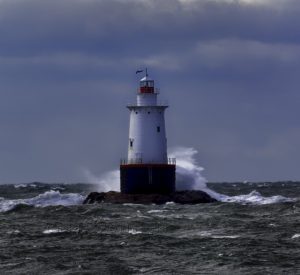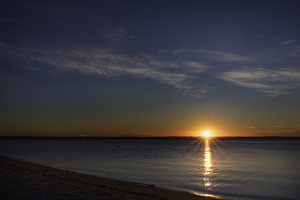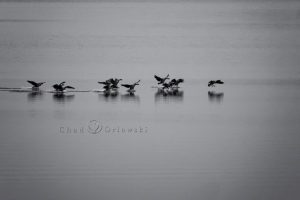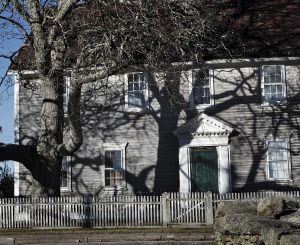Almost Getting It
This did not happen in my last shooting experience. This occurred today at the time of near sun set on a cloudy, windless day, in early December. Birds, geese and ducks were active or flocking, and the opportunities were happening hard and fast in things to photograph. All of a sudden, above me were several Canadian Geese coming in for a water landing. I quickly made sure my camera settings were adequate, and began making a series of shots as the geese approached and then landed. Surely, I said to myself, I must have at least one good photograph.
Unfortunately, if one considers sharpness as a critical element to a good photograph, I did not achieve my goal.
I offer the best of the lot for consideration and analysis in this blog post. I thought the lighting and form/movement/composition of the shot were what I wanted, and I am truly happy with those, but for some reason my camera settings were not adequate to achieving a sharp photograph. Maybe all things being equal, the lighting conditions were at the edge of what was achievable when you consider the fast movement of the landing geese. I will analyze this set of lighting, movement, and camera settings further to refine them so as to get a sharp shot.
The currently posted shot was taken on Occupexatuxet Cove using a Canon 5 DS, EF100-400mm f/4.5-5.6L IS II USM lens @ 400mm, f/8, 1/160″, ISO 1000, using DxO Optics Pro 11 for post processing, with Adobe Camera Raw, Photoshop CC(2018), and Silver Efex Pro.
Doing My Job
The Blog Post title is a take on Coach Bill Belichick’s oft used phrase “Do Your Job.” It was chosen to emphasize the challenge I have been trying to meet of “scouting” and being prepared to shoot photographs so as to make them something of which I could be proud.
The New England Patriot’s Football team had chosen Theodore F. Green Airport in Warwick, RI to be the airport where their airplane is stored and from which the team takes off for away games in the NFL. As the gods had ordained, I live only five minutes away from Green Airport, so I said it’s only fitting to try to capture a photograph of the team’s plane taking off.
Besides actually having a photo of the Patriot’s Plane as a fan, I thought that trying to take a photo of a plane taking off would help develop my photo and camera skills. This it actually did, for I had to figure out when the team’s pane would take off, find a vantage point to shoot without being stopped for security reasons, and finally try to get the most advantageous angle to shoot the photo. Actually choosing the camera settings was the easy part of the process.
There was a Warwick City Athletic Park adjacent to the airport so I could shoot without fear of police or security. The problem was that there was a wire fence surrounding the airport so my angle of shooting was drastically impeded, at least from capturing the plane lifting off. The next best angle was to capture the plane immediately airborne, which I did. [Notice the partially retracted landing gear (done 1-3 seconds after leaving the tarmac).]
The final hurdle to capturing the shot was that I was facing into the setting sun on a late fall day. The Patriot’s were choosing to leave for the away games in the late afternoon (c.3:30 and 4:30 PM). So, for a portion of my shots I was capturing a backlit plane. As the plane proceeded upward the background setting sun became less of a problem.
The current shot was the second time I visited Green Airport to record the Patriot’s Plane taking off. The first time was a disaster. Not only did I not realize that I would be shooting into the sun (at least part ways), but I ran out of CF card memory space. The above posted photo was taken with a Canon 5 DS, EF70-200mm f/4L IS USM @ 185mm, f/9.0, 1/400″, ISO 200, using DxO Optics Pro 11, Adobe Camera Raw, Photoshop CC (2018), a gradient map, and Color Efex Pro.
Picking Apples
The fall months of October and November have come and gone without my one desire being met of capturing the Milky Way during one of the new moons during those months. I’m beginning to realize that I must, indeed, plan in detail and in advance to get local shots (i.e., in Rhode Island) with local foreground objects (like light houses) in these Milky Way dreams.
I had tried to substitute for the above lack of opportunities by getting to know my State of Rhode Island better. I chose the northern part of the State since it is one I do not know and one which has remained somewhat resistant to modern changes. This part of Rhode Island is definitely historical and has beautiful rolling country sides of farms and orchards, with small villages and quaint farmhouses. There are many apple orchards and this currently posted shot of a farmhouse sits among one of these orchards.
The shot was taken on a windy, coolish fall day in the afternoon with the low angled sun behind me. The house was situated on one of the corners of a “busy” intersection. There definitely was not much traffic, but it still required being aware and off the road when traffic did show up. I parked at an apple orchard barn and asked the person there if I could park and shoot around the area (not going on the property, but simply shooting from the roadside). He stated there would be no problem. I had taken several hand held shots, but decided I’d like to use my tripod to make use of some of my neutral density filters to diminish the bright light of the angled sun. Before I could fully extend my tripod legs, the gentleman who previously agreed to let me shoot freely, now stated he did not want me shooting with my tripod because the owner of the house I was shooting might not like it (the owner was not on good terms with the gentleman with whom I was talking). I stated I understood, packed up my gear and moved on.
What the above experience has reinforced in me is that shooting photography is like picking apples. There are apples which you are allowed to pick and there are apple which the grower does not want you to pick. Furthermore, in the wider scope of photography, we have to pick and choose what apples to pick to make the best pie (aka photograph).
The above photo was taken with a Canon 5 DS, EF24-105mm @ 45mm, f/4L IS USM lens, f/10, 1/250″, 160 ISO, using DxO Optics Pro 11 in post processing, in addition to Adobe Camera Raw, PS CC (2018), a gradient map and Nik Color Efex Pro.
Staying in Shape
 A few days ago I had a most frustrating experience photographically, one which I have not had in many decades—I could not record the shot(s) onto my CF Card (it was full).
A few days ago I had a most frustrating experience photographically, one which I have not had in many decades—I could not record the shot(s) onto my CF Card (it was full).
The last time this ever happened to me was when I was shooting with actual photographic film (Kodak)—I had none in the camera.
The circumstances were thus: I had been hoping to get photos of the New England Patriots Plane taking off with the team on it to one of their games. I live very near T.F.Green Airport which is where the Patriots Plane is stored and from which the team departs to away games.
As luck would have it I was driving by the airport and noticed the plane loading with gear and players. I hurried home to get my camera and arrive at a City park right next to the airport which had a vantage point (not an optimal one, but acceptable for when the plane actually immediately lifts off) where I could shoot unimpeded. I was elated. But drawbacks were: it was cold with a northwest wind chill making it below freezing, and I was shooting into the setting sun.
Nonetheless, I figured that when the plane became airborne I would get some great clean shots. I was imposition and freezing (with numb fingers), the plane was lifting off a few yards from me, and the camera suddenly became unresponsive. All I could do is watch the Patriots plane fly beautifully off into the sunset without my glorious captured photographs of it.
My CF Card was full. I knew I had many photos on the card but was remiss in not deleting them.
The lesson I learned is you can not forget the basics of being prepared for the circumstances of shooting fleeting moments. Whether it’s weather, gear, knowing the circumstances, or things as lens cleaners, batteries, recording media, whatever. Attention to details means everything.
The posted photo is of Sakonnet Point Lighthouse, RI, on a blustery day in November, 2016, where again I was not prepared, since because of the wind, I was not able to get as many clear photos due to camera shake. I was on a tripod and about 1.5 feet off the ground but nonetheless, I was not prepared. The photo was taken with a Canon 5 DS, EF70-200mm f/4L IS USM lens @ 185mm, f22,1/80″, -0/67, ISO100, post processing with DxO Optics Pro 11, Adobe Camera Raw, using a gradient map in Photoshop, and Nik Color Efex Pro.
Meeting the Challenge
- At October 28, 2017
- By Firstmate
- In Canon EOS 5DS, DxO Optics Pro, Nik Software, RI
 0
0
 My recent trip to Hawaii continued to strengthen within me the adventure that photography is. Of course, for some individuals it is all consuming and it is a job unto itself, which is quite fine and I am grateful for these people for I learn from them. But for me the adventure comes in fits and spurts where photography fits in the spaces left void when other life events are not pressing.
My recent trip to Hawaii continued to strengthen within me the adventure that photography is. Of course, for some individuals it is all consuming and it is a job unto itself, which is quite fine and I am grateful for these people for I learn from them. But for me the adventure comes in fits and spurts where photography fits in the spaces left void when other life events are not pressing.
That is not to say photography is not far from my thinking and desires, for I am constantly planning and trying to make photography more a central player. Be that as it may, I have been forcing myself to give photography more of its due.
Recently, this has taken more form for me in that I have made two major lens purchases—a Canon EF16-35mm f/4L IS USM lens and a Canon EF100-400mm f/4.5-5.6L IS II USM lens. Both of these lens were at very appealing prices and I grabbed the opportunity to do so, even though it put some financial pressure on me to purchase them. Those purchases have forced me to make opportunities to use these lens, and I have been doing so over the last two months.
First of all, I will say I am not disappointed in my decision to makes these lens purchases, and secondly these lens have performed marvelously. They have stimulated me to think creatively, especially in how best to frame and use them.
Also, I must say that I am feeling very comfortable in shooting manually in many diverse situations as well as using my camera’s settings to maximize the best photo capture possible, and doing this dynamically, i.e., adjusting shooting on the changing conditions and needs at hand.
The currently posted photo is of Conimicut Point Light House at sunrise this past September. I was not content with the angling of this shot but I had no options based on accessibility. The photo was taken with a Canon 5DS, EF16-35mm f/4L IS USM @ 35mm, f/22, 1/4/”, ISO 50, used a six stop neutral density filter, post processed using DxO Optics Pro 11, Adobe Camera Raw, PS Gradient Map, and Nik Color Efex Pro.

 While my comfort and confidence levels continue to grow in taking photographs, the results are not always up to what I expected. Obviously, the elements of a great shot under a range of varying conditions is challenging, but I, nevertheless expect to at least get a good quality shot, at least with the top-notch, Canon equipment I use.
While my comfort and confidence levels continue to grow in taking photographs, the results are not always up to what I expected. Obviously, the elements of a great shot under a range of varying conditions is challenging, but I, nevertheless expect to at least get a good quality shot, at least with the top-notch, Canon equipment I use.

Recent Comments